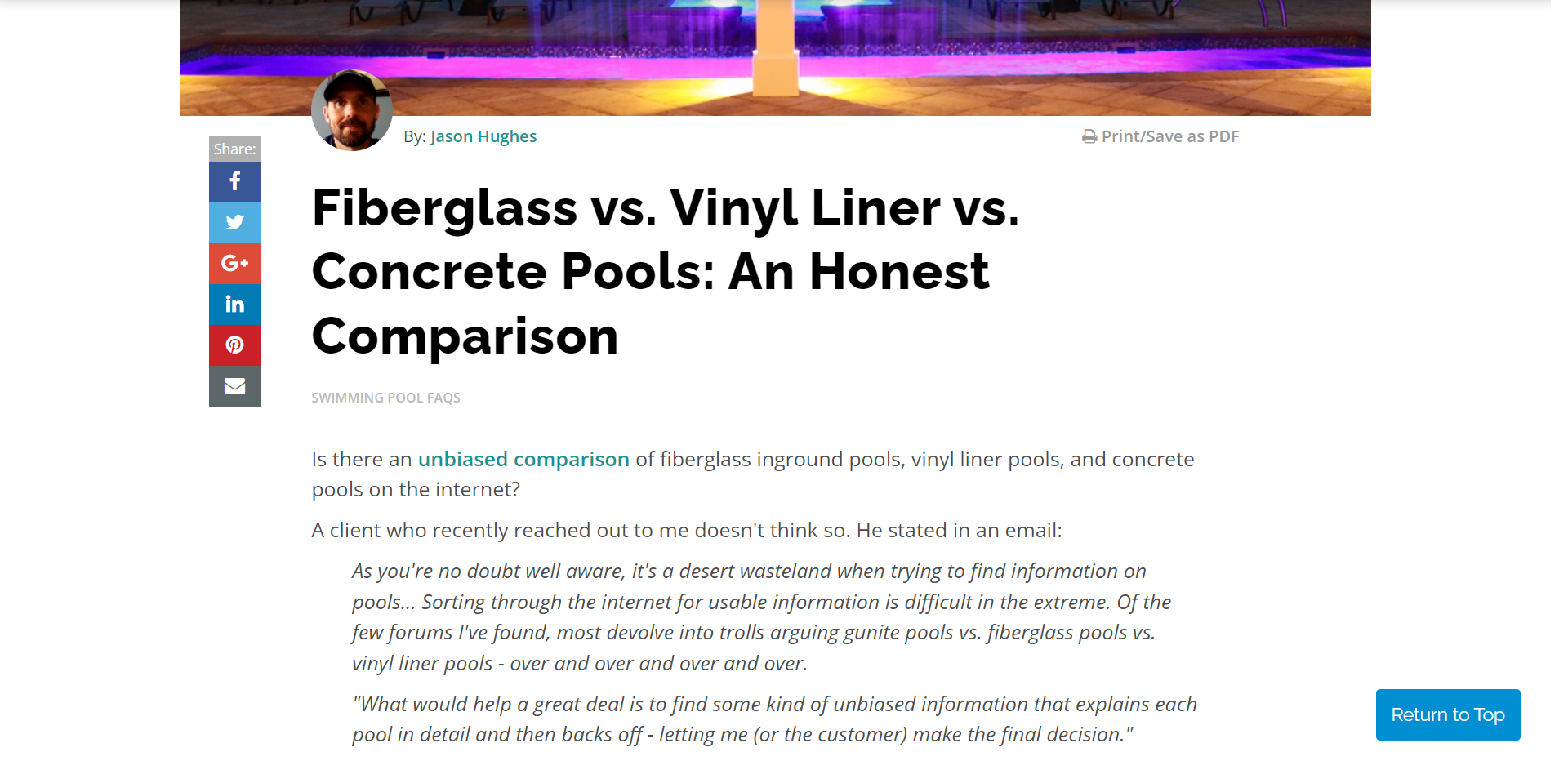The Big 5: The Best Blog Topic Categories To Drive Organic Traffic & Qualified Leads
Have you ever wondered why specific articles perform so well while others seem to just gather dust? Do you want to drastically increase the likelihood of your blog post not only generating organic website traffic but positively impacting the velocity of your sales cycle?
Marcus Sheridan identified five key blog topic categories that consistently outperform the rest: articles on price/cost, comparisons (i.e., this versus that), potential problems, best of, and reviews. After having written nearly 1,000 blog articles myself, I can attest to the truth.
In this blog post, we'll explore each type of article's key advantages and provide tips on how to craft them effectively. By the end of this article, you will understand why these strategies work so well and have a clear idea of how to create them yourself.
Table of Contents:
- They Ask, You Answer Content Strategy
- Price/Cost Articles
- Comparison/Versus Articles
- Potential Problems Articles
- Best Of Articles
- Review Articles
- Conclusion
What Is The They Ask, You Answer Content Strategy?
The They Ask, You Answer content strategy is a powerful framework within which businesses can better engage with customers and build trust. Developed by Marcus Sheridan on the simple principle that companies should answer their customers' questions honestly, transparently, and unbiasedly, this approach has proven effective in creating organic website traffic and generating leads.
Your buyers will spend the vast majority of their time researching your product or service online by themselves before (if ever) reaching out to your sales team. Every single time someone makes a considered purchase, they ask the same questions:
- How much does it cost? (Price/Cost)
- How do these solutions compare? Which is right for me? (Comparison & Versus)
- What are typical issues I should be aware of? (Potential Problems)
- What is the best solution available, and how close to "The Best" can I get? (Best Of)
- What do other people say about this? (Reviews)
Now, consider your content strategy. How many articles on your blog (or website pages) directly address pricing or your competition? For most companies, the answer would be not many. It is funny that organizations shy away from those questions that buyers almost always ask! And that is why They Ask, You Answer's Big 5 topics are so effective!
1. Price/Cost
Think about the last time you were trying to research something online. What happened when you didn't find the pricing on a website? Did you say to yourself, "Oh, that's fine. I understand that they aren't making their pricing public. I will just give them a call or request a quote instead," or did you think to yourself, "This company obviously has something to hide since they aren't sharing pricing information," and move on to the next website?
Did you know that almost no one buys lobster in a restaurant if it says "Market Price/Please ask!" on the menu? That's because people hate asking how much something costs! The same is true for anything we buy. We want to know whether something we are considering purchasing is within our budget. Studies show that buyers search for pricing for no more than 10 seconds before hitting the back button, returning to Google, and going to the next company.
How To Talk About Your Pricing The Right Way
In other words, price or cost-related posts effectively provide potential customers with information about how much your product or service costs without having them contact you directly, allowing your visitors to self-select whether or not your solution is within their budget.
If you don't want to discuss your pricing line-by-line, you can explain what makes the cost go up or down, what a top and bottom range would look like, and how to save money when purchasing your products or services. For example, if you’re selling software solutions, you could write a blog post outlining the different pricing tiers available and include advice on which one might be best suited for specific users.
Here are five sample blog post topics for passive house kit manufacturers:
- Passive House Kit Cost & Pricing Explained: A Guide
- What Factors Impact The Cost Of Passive Solar House Kits In 2023?
- 5 Ways You Can Reduce Or Inflate Your Passive House Kit Cost
- How Much Do Lumber Price Increases Impact Passive House Kit Pricing?
- Calculating The Return on Investment In A Passive House In Heat Savings In the 2022/2023 Energy Crisis
While the first is a much more comprehensive guide to how passive house kits are priced in general and in your region/firm in particular, the others are supplemental blog posts that answer buyers' questions in more depth or address current concerns.
Best Practices When Writing About Cost & Pricing
When writing a price/cost article, provide data-driven research that supports your claims. This could include surveys, industry reports, customer reviews, or any other relevant sources of information.
You should also provide comparisons to similar products or services so that readers can get an idea of how much they would be spending on each option. Additionally, outlining potential savings or return-on-investment calculations are excellent ways to demonstrate value for money and encourage people to purchase from you instead of competitors.
It’s also essential to keep your tone professional while still making the content relatable for readers. Use language that resonates with them and explain why certain costs may be higher than others without being too technical or promotional. Lastly, avoid using exclamation points, as this can be unprofessional and detract from the overall message you’re trying to convey.
And please don't frustrate your readers with a bait and switch, meaning don't say you will explain your cost and pricing and then tell them to get a quote without giving them any additional information.
2. Comparisons & Versus
Because our buyers go through a selection process during their buyer journey, they have to compare different solutions with each other. Versus or comparison posts are great for helping readers understand the differences between two or more solution approaches. These can be two similar products or services your company offers, or very different means to reach the same goal. A great example is this post.

And these are the type of comments they are getting for it:

By comparing the three options honestly, transparently, and unbiasedly, River Pools & Spas has not only created trust with its buyers, but has also established itself as a thought leader.
How To Tackle Comparison Posts The Right Way
A comparison or versus article is a great way to drive organic website traffic and generate leads. By providing an objective analysis of two products or services, readers can make informed decisions about which one is best for them. For instance, if you offer both web hosting packages and cloud storage plans, then writing a comparison post explaining the pros and cons of each would be beneficial for potential buyers who may not know which option is right for them.
When writing comparisons or versus articles, it’s vital to use data-driven research that supports your conclusions. You might ruffle some feathers, so document everything honestly and without bias. Remember: The point is not to polish certain facts so that you emerge as the leader, but is instead to provide the reader with the facts they need to make the right decision for them. And that might not be your company — which is a good thing as they would have been a bad fit anyway!
Best Practices When Writing Versus Articles
To write effective comparisons or versus articles, consider using a simple structure such as “Pros & Cons” or “Features & Benefits” when outlining each product or service. This makes it easier for readers to quickly identify key points in both options and compare them side by side.
Additionally, focus on highlighting unique features between the two options rather than simply listing all features available in both products/services. This will help create more engaging content that captures readers' attention and drives conversions.
Finally, don't forget to add visuals like charts and graphs whenever possible. Visuals help break up text-heavy content while also making complex topics easier for readers to digest. Plus, they look great too.
3. Potential Problems
Imagine you are buying a washing machine. What are the questions you might have? I bet many of them center around potential problems (e.g., Which models are the most reliable? Which have the most maintenance issues?).
Yale Appliance used They Ask, You Answer's content strategy and highlighted for years the most reliable washing machine (e.g., the most reliable front-loading washing machines in 2022) and other appliances. It helped them grow their business from a small local vendor to a national force to be reckoned with in the appliance space.

How To Write About Potential Issues Effectively
Potential problem posts can help inform readers about common issues they may encounter when using your product or service before they make a purchase decision. These types of posts can also serve as preventative measures against customer complaints down the line since the posts show that you are aware of any potential problems that could arise from using your offering(s).
But even more importantly, these posts allow buyers to get the complete picture of what to expect before purchasing so they can make the right decision for them. So again: be honest and transparent!
Best Practices When Writing Problems Posts
When writing a potential problems article, be sure you can back up any claims made in the post with relevant and up-to-date data. This helps ensure that readers have access to reliable information when making decisions about products or services they may be interested in purchasing. Additionally, an objective analysis should be provided throughout the post so that readers can make informed decisions based on facts rather than opinions.
In addition to providing accurate information, it is helpful to outline possible solutions for the issue(s) at hand. By doing this, authors can help their readers to understand how impactful the problem is and how easily these issues can be resolved. For example, is it just a matter of getting a replacement part you can install yourself, or do you need to buy a new product?
Finally, authors should strive for clarity when writing potential problems articles by avoiding jargon whenever possible and breaking down complex topics into more manageable pieces of information that can easily be understood by all audiences regardless of their technical background knowledge on the subject matter being discussed.
4. Best Of
Humans are always hardwired to want the best of the best, and if we cannot afford the best, we at least want to know how close we can get to it and what the best option is that we can afford. Examples of these articles are plentiful in the B2C space, e.g., best portable projectors under $500. But in the B2B space, this kind of transparency is much harder to find, unless it is through a third party, like an analyst company.
How To Write Great "Best Of" Articles
Let's address one common misconception right out of the gate: Best Of articles are not meant to be lists of products/services/companies that compete with you, nor are they meant to be opportunities for you to showcase why you are better than anyone else. Rather, they should allow the reader to understand what the top standard in the market looks like.
Having said that, where on the list should you place your company/product? Well, the answer might surprise you, but you shouldn't put yourself on the list at all! The person reading the article is already on your site, seeing you as a thought leader. However, there are good ways to do this and bad/ineffective ways to do this.
Best Practices When Writing "Best Of" Articles
As with every other They Ask, You Answer Big 5 topic, it is essential to be truthful and unbiased. This can be hard for some companies, especially in the B2B space, that are so used to tooting their own horns on their blogs. So put yourself in your buyer's shoes and map out the best options for their problems.
Best Of articles can highlight
- Different solution approaches or best practices (e.g., explaining why oak hardwood flooring is superior to pine),
- Companies (e.g., The Best Passive House Kit Construction Companies In The Tri-State Area), or
- Specific products or services (e.g., The Best Passive House Kit Provider For Small Residences [Under 1,500 Square Feet]).
5. Review Articles
95% of buyers look at reviews before making a purchase decision, which makes review articles an indispensable topic in your content strategy. Review articles are closely related to Best Of articles. They provide readers with an objective analysis of a product or service, helping them make informed decisions about their purchase.
How To Write Great Review Articles
Review articles are great tools for building credibility around your brand since they give current/potential customers an opportunity to hear what other people think about it before making their own decisions regarding whether or not it’s worth investing in (or continuing to use).
While it is tempting to only include quotes from users who have had positive experiences, as they will go a long way toward convincing skeptical readers, you should offer an unbiased review. It’s important to keep in mind that reviews should be unbiased and honest. No matter how good the product or service may be, there will always be some drawbacks that need to be addressed to give an accurate representation of what it offers.
Best Practices When Writing Review Articles
Providing detailed descriptions of the pros and cons associated with each product or service can help readers decide which one is best suited for their needs. Also, including real customer testimonials can add credibility to your review article and provide further insight into how others have benefited from using the product or service that is being reviewed.
Conclusion
In conclusion, the Big 5 content strategy outlined by They Ask, You Answer is a great way to generate organic website traffic and leads. By focusing on price/cost, comparison or versus, potential problems, best of, and review articles, you can create content that resonates with your target audience.
Are you looking to increase sales and improve your marketing strategies? 3P Creative Group can help. We offer They Ask, You Answer Mastery coaching and inbound marketing services to give you an edge over your competition. Let us show you how we can elevate your business through our innovative approach today!
Share this
You May Also Like
These Related Stories

How To Write A Big 5 Comparison Article That Builds Trust

The 5 Blog Topic Categories For Interior Designers To Attract More Traffic & Convert New Clients

.png?width=250&height=125&name=TrustBuilderLogoWhiteTranspBackgr(250x125%20px).png)




No Comments Yet
Let us know what you think